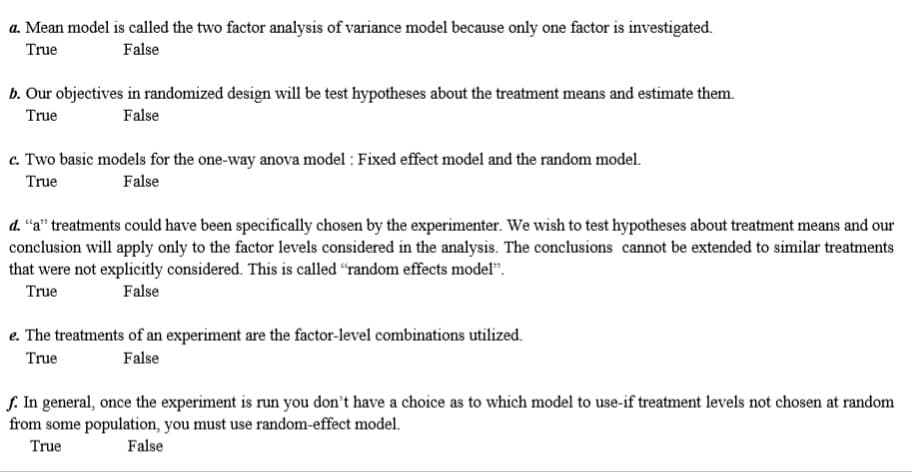Mean model is called the two factor analysis of variance model because only one factor is investigated. True False Our objectives in randomized design will be test hypotheses about the treatment means and estimate them. True False
Mean model is called the two factor analysis of variance model because only one factor is investigated. True False Our objectives in randomized design will be test hypotheses about the treatment means and estimate them. True False
Holt Mcdougal Larson Pre-algebra: Student Edition 2012
1st Edition
ISBN:9780547587776
Author:HOLT MCDOUGAL
Publisher:HOLT MCDOUGAL
Chapter11: Data Analysis And Probability
Section11.4: Collecting Data
Problem 2E
Related questions
Concept explainers
Contingency Table
A contingency table can be defined as the visual representation of the relationship between two or more categorical variables that can be evaluated and registered. It is a categorical version of the scatterplot, which is used to investigate the linear relationship between two variables. A contingency table is indeed a type of frequency distribution table that displays two variables at the same time.
Binomial Distribution
Binomial is an algebraic expression of the sum or the difference of two terms. Before knowing about binomial distribution, we must know about the binomial theorem.
Topic Video
Question
100%
9

Transcribed Image Text:a. Mean model is called the two factor analysis of variance model because only one factor is investigated.
True
False
b. Our objectives in randomized design will be test hypotheses about the treatment means and estimate them.
True
False
c. Two basic models for the one-way anova model : Fixed effect model and the random model.
True
False
d. “a" treatments could have been specifically chosen by the experimenter. We wish to test hypotheses about treatment means and our
conclusion will apply only to the factor levels considered in the analysis. The conclusions cannot be extended to similar treatments
that were not explicitly considered. This is called “random effects model".
True
False
e. The treatments of an experiment are the factor-level combinations utilized.
True
False
J. In general, once the experiment is run you don't have a choice as to which model to use-if treatment levels not chosen at random
from some population, you must use random-effect model.
True
False
Expert Solution
This question has been solved!
Explore an expertly crafted, step-by-step solution for a thorough understanding of key concepts.
Step by step
Solved in 3 steps

Knowledge Booster
Learn more about
Need a deep-dive on the concept behind this application? Look no further. Learn more about this topic, statistics and related others by exploring similar questions and additional content below.Recommended textbooks for you

Holt Mcdougal Larson Pre-algebra: Student Edition…
Algebra
ISBN:
9780547587776
Author:
HOLT MCDOUGAL
Publisher:
HOLT MCDOUGAL

Glencoe Algebra 1, Student Edition, 9780079039897…
Algebra
ISBN:
9780079039897
Author:
Carter
Publisher:
McGraw Hill

College Algebra (MindTap Course List)
Algebra
ISBN:
9781305652231
Author:
R. David Gustafson, Jeff Hughes
Publisher:
Cengage Learning

Holt Mcdougal Larson Pre-algebra: Student Edition…
Algebra
ISBN:
9780547587776
Author:
HOLT MCDOUGAL
Publisher:
HOLT MCDOUGAL

Glencoe Algebra 1, Student Edition, 9780079039897…
Algebra
ISBN:
9780079039897
Author:
Carter
Publisher:
McGraw Hill

College Algebra (MindTap Course List)
Algebra
ISBN:
9781305652231
Author:
R. David Gustafson, Jeff Hughes
Publisher:
Cengage Learning
